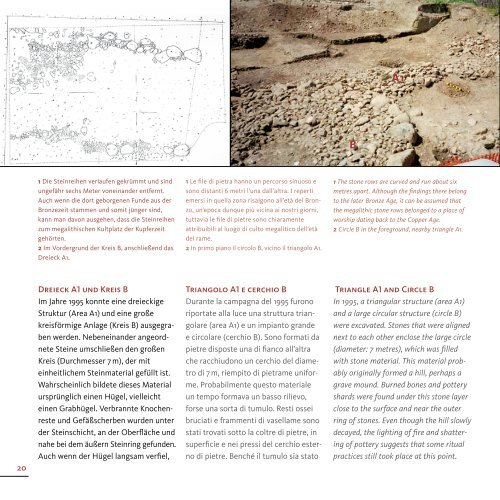Un regno di pietre. - Rete Civica dell'Alto Adige
Un regno di pietre. - Rete Civica dell'Alto Adige
Un regno di pietre. - Rete Civica dell'Alto Adige
Create successful ePaper yourself
Turn your PDF publications into a flip-book with our unique Google optimized e-Paper software.
20<br />
1 Die Steinreihen verlaufen gekrümmt und sind<br />
ungefähr sechs Meter voneinander entfernt.<br />
Auch wenn <strong>di</strong>e dort geborgenen Funde aus der<br />
Bronzezeit stammen und somit jünger sind,<br />
kann man davon ausgehen, dass <strong>di</strong>e Steinreihen<br />
zum megalithischen Kultplatz der Kupferzeit<br />
gehörten.<br />
2 Im Vordergrund der Kreis B, anschließend das<br />
Dreieck A1.<br />
Dreieck A1 und Kreis B<br />
Im Jahre 1995 konnte eine dreieckige<br />
Struktur (Area A1) und eine große<br />
kreisförmige Anlage (Kreis B) ausgegraben<br />
werden. Nebeneinander angeordnete<br />
Steine umschließen den großen<br />
Kreis (Durchmesser 7 m), der mit<br />
einheitlichem Steinmaterial gefüllt ist.<br />
Wahrscheinlich bildete <strong>di</strong>eses Material<br />
ursprünglich einen Hügel, vielleicht<br />
einen Grabhügel. Verbrannte Knochenreste<br />
und Gefäßscherben wurden unter<br />
der Steinschicht, an der Oberfläche und<br />
nahe bei dem äußern Steinring gefunden.<br />
Auch wenn der Hügel langsam verfiel,<br />
1 Le file <strong>di</strong> pietra hanno un percorso sinuoso e<br />
sono <strong>di</strong>stanti 6 metri l’una dall’altra. I reperti<br />
emersi in quella zona risalgono all’età del Bronzo,<br />
un’epoca dunque più vicina ai nostri giorni,<br />
tuttavia le file <strong>di</strong> <strong>pietre</strong> sono chiaramente<br />
attribuibili al luogo <strong>di</strong> culto megalitico dell’età<br />
del rame.<br />
2 In primo piano il circolo B, vicino il triangolo A1.<br />
Triangolo A1 e cerchio B<br />
Durante la campagna del 1995 furono<br />
riportate alla luce una struttura triangolare<br />
(area A1) e un impianto grande<br />
e circolare (cerchio B). Sono formati da<br />
<strong>pietre</strong> <strong>di</strong>sposte una <strong>di</strong> fianco all’altra<br />
che racchiudono un cerchio del <strong>di</strong>ametro<br />
<strong>di</strong> 7 m, riempito <strong>di</strong> pietrame uniforme.<br />
Probabilmente questo materiale<br />
un tempo formava un basso rilievo,<br />
forse una sorta <strong>di</strong> tumulo. Resti ossei<br />
bruciati e frammenti <strong>di</strong> vasellame sono<br />
stati trovati sotto la coltre <strong>di</strong> <strong>pietre</strong>, in<br />
superficie e nei pressi del cerchio esterno<br />
<strong>di</strong> <strong>pietre</strong>. Benché il tumulo sia stato<br />
1 The stone rows are curved and run about six<br />
metres apart. Although the fin<strong>di</strong>ngs there belong<br />
to the later Bronze Age, it can be assumed that<br />
the megalithic stone rows belonged to a place of<br />
worship dating back to the Copper Age.<br />
2 Circle B in the foreground, nearby triangle A1.<br />
Triangle A1 and Circle B<br />
In 1995, a triangular structure (area A1)<br />
and a large circular structure (circle B)<br />
were excavated. Stones that were aligned<br />
next to each other enclose the large circle<br />
(<strong>di</strong>ameter: 7 metres), which was filled<br />
with stone material. This material probably<br />
originally formed a hill, perhaps a<br />
grave mound. Burned bones and pottery<br />
shards were found under this stone layer<br />
close to the surface and near the outer<br />
ring of stones. Even though the hill slowly<br />
decayed, the lighting of fire and shattering<br />
of pottery suggests that some ritual<br />
practices still took place at this point.



